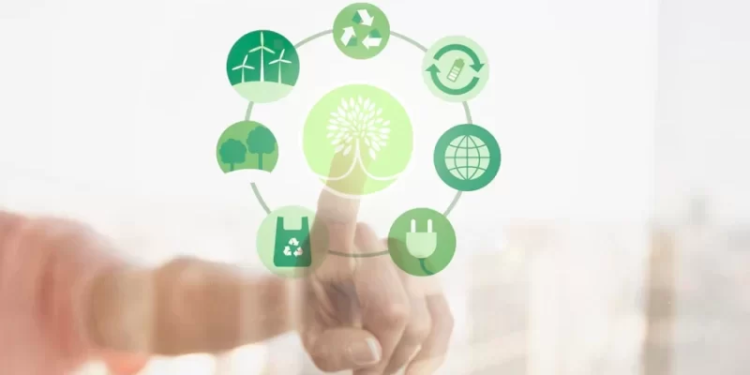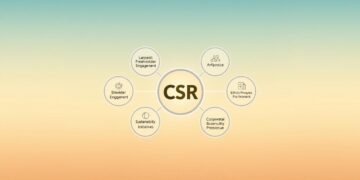As resources diminish and pollution increases, many experts are promoting a different approach to business: the circular economy. This model moves away from the conventional “take-make-dispose” method, focusing instead on keeping materials in use and minimizing waste. Adopting this system can aid in addressing climate change, protecting natural habitats, and generating new employment opportunities.
This article examines the importance of transitioning to a circular economy for a sustainable future.
Understanding the Circular Economy
The circular economy emphasizes concepts such as waste and pollution elimination, product and material circulation, and nature regeneration. This model contrasts with the linear economy, which typically involves a “take-make-dispose” framework. Understanding the circular economy supports sustainability by advocating for sharing, reusing, and recycling, thereby enhancing resource efficiency across various sectors.
For instance, businesses can implement circular business models that prioritize leasing products instead of outright sales, enabling repairs and refurbishments instead of disposal. Companies can evaluate their processes by analyzing input and output flows, uncovering opportunities for remanufacturing, and creating resource loops that extend the lifespan of materials. Approaches like industrial ecology and biomimicry can inform these evaluations by inspiring innovative design solutions that lessen raw material use and decrease pollution.
By moving toward circular development, organizations can align their operations with economic growth and environmental health, addressing climate change and working towards a zero waste society, as advocated by the Ellen MacArthur Foundation and the European Parliament.
Benefits of the Circular Economy
Environmental Sustainability
The circular economy emphasizes environmental sustainability by promoting responsible resource use through principles like reducing waste, recycling, and designing for a cradle-to-cradle approach. This model encourages businesses to rethink traditional linear systems, focusing on resource efficiency and minimizing pollution.
Organizations can measure their sustainability impact by tracking resource consumption, waste management practices, and implementing circular business models that include leasing, repairing, and refurbishing products. They can also assess contributions to climate change mitigation and economic growth with metrics related to resource loops and regeneration. Education is important, and communities can learn about sustainability by engaging in programs showcasing industrial ecology concepts, such as biomimicry and industrial symbiosis. Encouraging sharing, reusing, and adopting zero waste practices increases awareness of their part in protecting nature.
As they understand the benefits of circular development, individuals and businesses can foster a more resilient economy that supports renewable energy and reduces the use of raw materials, further aiding in effective waste and pollution management.
Economic Efficiency
Economic efficiency boosts the overall effectiveness of the circular economy by promoting responsible resource consumption and reducing waste and pollution. Organizations can assess and enhance their economic efficiency through various methods, such as adopting circular business models that emphasize sharing, reusing, and recycling products and materials. This includes strategies like leasing, repairing, and refurbishing items to extend their life cycle and lessen the need for new raw materials.
Resource optimization is fundamental in the circular economy, as it supports the creation of resource loops that help maintain the value of materials while minimizing waste. For instance, businesses can implement solutions inspired by biomimicry and industrial ecology to design products that seamlessly integrate back into nature or the economy, promoting regenerative practices.
The Ellen MacArthur Foundation underscores that transitioning to these circular development models can generate substantial economic growth, while the European Parliament advocates for initiatives that further zero waste and resource efficiency to address climate change and global warming. This way, enriched economic activity through effective waste management and industrial symbiosis contributes to a more sustainable economic system.
Ellen MacArthur Foundation and Circular Economy
The Ellen MacArthur Foundation promotes circular economy principles by encouraging industries to adopt sustainable practices such as recycling, remanufacturing, and sharing. It emphasizes the need to eliminate waste and pollution by designing products for a longer life cycle. By showcasing circular business models and resource loops, the foundation highlights pathways to increased resource efficiency and economic growth.
It evaluates the impact of these initiatives through studies that monitor pollution reduction and raw materials usage, demonstrating how moving from a linear economy to a circular one can lessen climate change effects and enhance sustainability. The foundation educates businesses and policymakers on the advantages of circular development through resources that explain methodologies like biomimicry and cradle to cradle design.
By presenting real-world examples of successful practices in areas like food systems and renewable energy, the foundation illustrates how industrial ecology and practices such as industrial symbiosis can contribute to a regenerative economy. Its work promotes understanding of how effective waste management and repairability can transform economic activities into a zero-waste system that benefits both nature and society.
Key Principles of the Circular Economy
Design for Longevity
Designs that prioritize longevity extend the life of products and reduce waste by emphasizing durability and reparability. By integrating principles from industrial ecology and biomimicry, designers can create long-lasting and easily maintained items. This approach involves selecting high-quality materials that withstand wear, enabling straightforward repairs, and including modular components for upgrades.
Circular business models, such as leasing or sharing options, allow for the maintenance of products within resource loops, leading to a decrease in overall resource use.
Raising awareness among consumers about the advantages of durable products can help change views on disposable options. Initiatives may include campaigns that highlight the effects of waste and pollution on the environment, climate change, and the benefits of renewable energy.
Additionally, companies can advocate for cradle-to-cradle design strategies, illustrating how investments in durable products support sustainability and economic growth. Providing information on recycling and remanufacturing can aid consumers in making informed decisions, fostering a culture of zero waste and circular development.
Maintain and Restore Resources
Organizations can implement strategies like designing products for durability, which allows for repair and refurbishment, to effectively maintain resources throughout the product lifecycle. By adopting circular business models, businesses can focus on sharing and reusing products, minimizing waste and pollution while maximizing resource efficiency.
The restoration of depleted resources contributes to a successful circular economy by creating material loops that regenerate natural ecosystems andpromote sustainability, helping to combat climate change. Practices such as remanufacturing and leasing allow businesses to reduce their reliance on raw materials and encourage regenerative practices that enhance biodiversity. Engaging in industrial symbiosis can further facilitate resource sharing between businesses, promoting economic growth within the circular economy.
The design principles of cradle to cradle and biomimicry can guide companies in developing products that sustain both natureand the economy. By focusing on waste management and reducing resource consumption, organizations can support a transition to a zero waste future backed by the European Parliament, fostering a resilient economic system that benefits everyone.
Emphasize Recycling and Reuse
Emphasizing recycling and reuse is significant in reducing waste and conserving resources within a circular economy. By focusing on the life cycle of products, businesses can adopt circular business models that include remanufacturing, leasing, and refurbishing items, which helps maintain resource loops and minimizes pollution.
Organizations can encourage consumers to engage in these practices by promoting awareness of waste management and sustainability initiatives, such as zero waste programsand sharing platforms. Individuals can also contribute positively by prioritizing recycling and reusing materials in their daily lives, choosing products designed with cradle to cradle principles or industrial ecology in mind. When people actively participate in circular development, they help foster economic growth while reducing resource consumption and combating climate change.
By relying on renewable energy and efficient resource management, society can transition from a linear economy to one that values sustainability, focusing on the needs of people and nature. Embracing biomimicry and aiming for resource efficiency ensures that the economy remains regenerative while protecting the environment for future generations.
Challenges in Transitioning to a Circular Economy
Organizations encounter various challenges when trying to incorporate circular economy principles into their current business models. A lack of comprehension about resource loops and circularity can hinder the design of products that focus on reducing waste and pollution.
Regulatory frameworks from entities like the European Parliament can either facilitate or obstruct this transition; strict waste management policies might promote recycling and remanufacturing, whereas ambiguous guidelines canlead to confusion. Cultural and behavioral elements play a significant part in this shift, as consumers must adopt sharing, reusing, and repairing practices for circular development to thrive. In businesses, traditional linear economy mindsets can impede the adoption of sustainable changes, such as renewable energy usage and cradle-to-cradle design implementation.
Additionally, the demand for innovative solutions in industrial ecology, like leasing and refurbishing, often conflicts with established behaviors. These challenges underscore the need for a new approach to resource consumption to enhance sustainability and address climate change effectively, ultimately enabling economic growth while reducing waste and pollution.
Steps to Move Towards Circular Economy
Adopt Sustainable Materials
Sustainable materials should aim to reduce waste and pollution, support recycling, and cut resource usage to align with principles of the circular economy. Opting for renewable resources, especially those that follow cradle-to-cradle designs, helps ensure products enhance nature and restore ecosystems. Companies can efficiently obtain these materials through circular business models that highlight sharing, reusing, and repairing while maintaining quality and cost-effectiveness.
For example, leasing items allows businesses to reclaim materials at the end of their life cycles, creating resource loops that keep valuable goods in circulation. This method promotes resource efficiency and collaboration between different sectors to minimize pollution and waste. By adopting sustainable materials, companies advance their environmental objectives, such as reducing carbon footprints and addressing climate change, which can improve brand reputation and attract eco-conscious consumers.
The shift towards these practices promotes economic growth while fostering a regenerative economy, ultimately contributing to a sustainable future as outlined by the Ellen MacArthur Foundation and the European Parliament’s initiatives.
Implement Circular Design
Organizations can effectively integrate circular design principles by focusing on the entire life cycle of products. This includes designing for durability, repairability, and recyclability, which aligns with the ideas proposed by the Ellen MacArthur Foundation. Strategies such as leasing and remanufacturing can be applied to create circular business models that extend the lifespan of products, ensuring resource loops are maintained.
Collaboration among stakeholders—including businesses, the European Parliament, and communities—can enhance resource efficiency and aid in waste management through industrial symbiosis. This collective effort supports a shift from the traditional economy by sharing, reusing, and refurbishing materials. Companies can adopt techniques from industrial ecology and biomimicry to encourage regenerative practices that improve sustainability.
Engaging in these practices not only reduces pollution but also addresses climate change, contributing to economic growth through innovative products and services. By embracing circularity, industries can achieve zero waste goals, manage raw materials wisely, and create a more responsible economic system that values renewable energy and minimizes resource consumption.
Future of Circular Economy
Emerging technologies like artificial intelligence and blockchain are set to enhance resource efficiency in the circular economy, improving waste management through better sorting and tracking of materials. Innovations in industrial ecology can optimize resource loops, making recycling and remanufacturing processes more effective.
As consumers become more conscious of sustainability, their behaviors may shift towards sharing, reusing, and repairing products instead of adhering to the traditional linear model of consumption. This change in preference could boost the demand for circular business models and design practices that focus on cradle to cradle principles. Furthermore, government initiatives, such as those from the European Parliament, can foster economic growth by incentivizing zero waste policies and backing renewable energy projects.
These measures can stimulate circular development by reducing waste and pollution while promoting the use of technical materials and regenerative practices. This transition will need collaboration among businesses that adopt leasing models and those that prioritize refurbishing and recycling materials to create a more efficient economic system oriented toward sustainability and climate change mitigation.
FAQ
What are the environmental benefits of transitioning to a circular economy?
Transitioning to a circular economy reduces waste and pollution by reusing materials and minimizing resource extraction. For example, recycling plastic bottles into new products saves energy and lowers greenhouse gas emissions, while upcycling textiles can divert waste from landfills, promoting sustainable consumption and production practices.
How does a circular economy contribute to economic growth and job creation?
A circular economy fosters innovation, boosts resource efficiency, and creates new business opportunities. For example, companies that recycle materials or refurbish products can lower costs and generate jobs in manufacturing and repair services, ultimately stimulating economic growth and providing sustainable employment.
What role do consumers play in supporting a circular economy?
Consumers support a circular economy by choosing sustainable products, repairing items instead of discarding them, participating in recycling programs, and buying secondhand. For example, using reusable bags and shopping at thrift stores helps reduce waste and promotes the lifecycle of products.
How can businesses effectively shift from a linear to a circular economy model?
Businesses can shift to a circular economy by redesigning products for durability and recyclability, using sustainable materials, and adopting take-back programs. For example, a clothing brand can implement a recycling initiative for old garments, while a tech company might create modular devices for easy repair and upgrade.
What challenges do we face in moving towards a circular economy, and how can they be addressed?
Challenges include insufficient infrastructure, lack of consumer awareness, and high initial costs. Addressing these requires investing in waste management systems, educating consumers on recycling, and providing incentives for businesses adopting circular practices, such as tax breaks or subsidies for sustainable materials.












